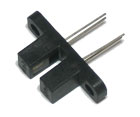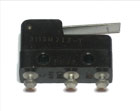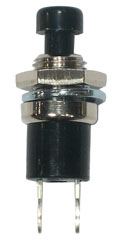- Type: Mechanical switch
- Range: A few mm, depending on switch sensitivity
- Cost: $1
- Distributors: Digikey, Mouser, Jameco, and most other electronics shops
- Example datasheet
Reed switches are activated by magnets: when a magnet gets close, the switch closes. They are a little delicate, but are very inexpensive and common. They should be connected as a digital input into a Analog/Digital I/O MIDIsense with one pin connected to ground and the other to the input port.
- Type: Powered digital output sensor
- Range: 2-10mm gap size
- Cost: $1
- Distributors: Mouser, Digikey, etc.
- Example datasheet for part # GP1S094HCZ
Photo interruptors consist of an IR (infrared) LED and an IR detector aligned across a gap. When something is in the gap ("interrupts" the IR beam) the detector switch turns 'off' and when the IR beam hits the sensor, the switch turns on. To use this, the LED must be wired on to +5V (with a series resistor, 200-1K is probably not a bad value) and the detector connected to an input switch with the pull-up resistor turned on. Check the package/datasheet for your sensor to find out how to connect it up: The LED cathode and detector emitter are connected to ground, the LED anode is connected thru a resistor to +5V and the detector cathode is connected to the switch input of an Analog/Digital Input/Output midisense board.
- Type: Mechanical switch
- Range: 5-15 degrees
- Cost: $2
- Available from: Mouser, Elexp
- Example datasheet
Tilt switches come in two varieties: roller ball (top image) or mercury (lower image). Basically they work the same, the ball and mercury are conductive, so when the switch is right side up, the ball/mercury short the two connectors and the switch is closed. When tilted off-axis, the ball or mercury rolls away and the switch opens. Mercury switches are slightly harder to come by because they are no longer manufactured, but Elexp seems to still have them in stock. Tilt switches should be connected as a digital input into a "Analog/Digital I/O" MIDIsense.
- Type: Mechanical switch
- Available from: Jameco, etc
- Cost: $2-$5






